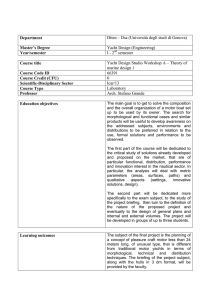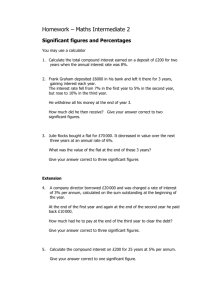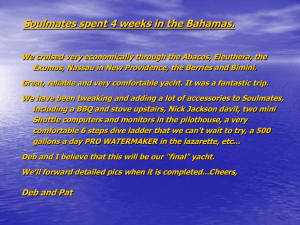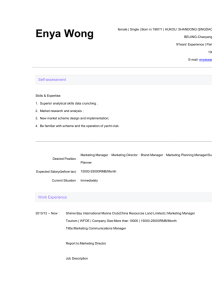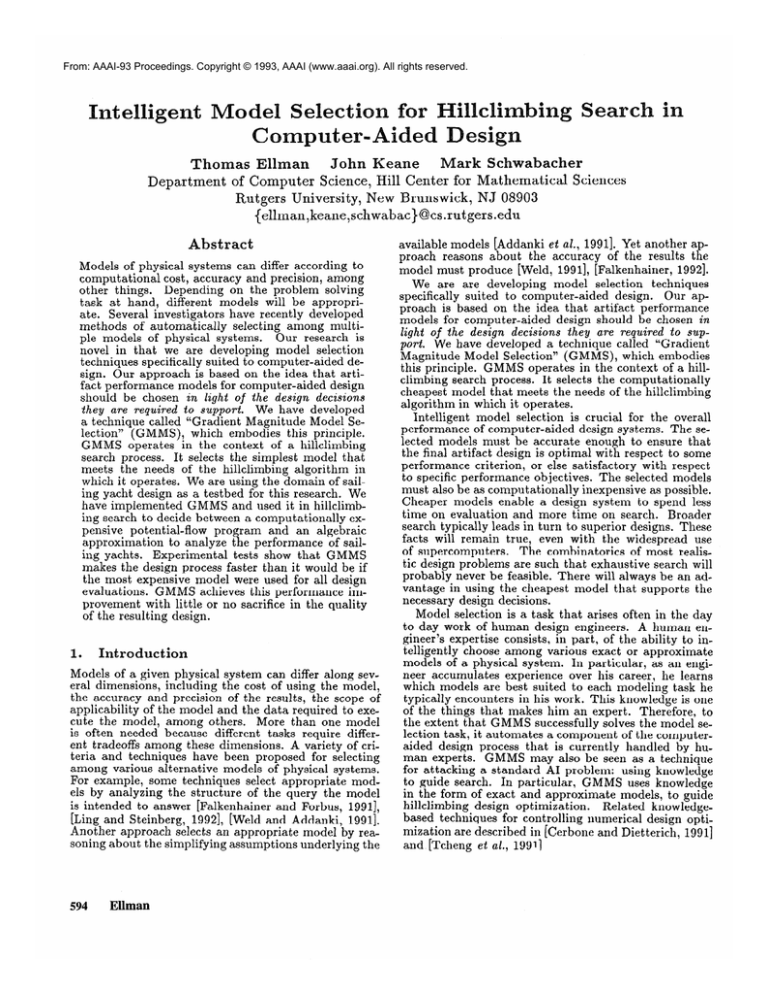
From: AAAI-93 Proceedings. Copyright © 1993, AAAI (www.aaai.org). All rights reserved.
esig
Mark Schwabacher
John Keane
Thomas Elhan
Department of Computer Science, Hill Center for Mathematical Sciences
Rutgers University, New Brunswick, NJ 08903
{ellman,keane,schwabac}@cs.rutgers.edu
Abstract
Models of physical systems can differ according to
computational
cost, accuracy and precision, among
Depending
on the problem solving
other things.
task at hand, different models will be appropriate. Several investigators
have recently developed
methods of automatically
selecting among multiple models of physical systems.
Our research is
novel in that we are developing model selection
techniques specifically suited to computer-aided
design. Our approach is based on the idea that artifact performance
models for computer-aided
design
should be chosen in light of the design decisions
they are required to support.
We have developed
a technique called “Gradient Magnitude Model Selection” (GMMS),
which embodies this principle.
GMMS operates in the context of a hillclimbing
search process.
It selects the simplest model that
meets the needs of the hillclimbing
algorithm
in
which it operates.
We are using the domain of sailing yacht design as a testbed for this research. We
have implemented
GMMS and used it in hillclimbing search to decide between a computationally
expensive potential-flow
program and an algebraic
approximation
to analyze the performance
of sailing yachts.
Experimental
tests show that GMMS
makes the design process faster than it would be if
the most expensive model were used for all design
evaluations.
GMMS achieves this performance
improvement with little or no sacrifice in the quality
of the resulting design.
1.
Introduction
Models of a given physical system can differ along several dimensions,
including the cost of using the model,
the accuracy and precision of the results, the scope of
applicability
of the model and the data required to execute the model, among others.
More than one model
is often needed because different tasks require different tradeoffs among these dimensions.
A variety of criteria and techniques
have been proposed for selecting
among various alternative
models of physical systems.
For example, some techniques select appropriate
models by analyzing the structure of the query the model
is intended to answer [Falkenhainer
and Forbus, 19911,
[Ling and Steinberg,
19921, [Weld and Addanki, 19911.
Another approach selects an appropriate model by reasoning about the simplifying assumptions underlying the
594
Ellman
available models [Addanki et al., 19911. Yet another approach reasons about the accuracy of the results the
model must produce [Weld, 19911, [Falkenhainer,
19921.
We are are developing
model selection
techniques
specifically suited to computer-aided
design.
Our approach is based on the idea that artifact performance
models for computer-aided
design should be chosen in
light of the design decisions they are required to support. We have developed a technique called “Gradient
Magnitude Model Selection” (GMMS),
which embodies
this principle. GMMS operates in the context of a hillclimbing search process. It selects the computationally
cheapest model that meets the needs of the hillclimbing
algorithm in which it operates.
Intelligent
model selection is crucial for the overall
performance of computer-aided
design systems. The selected models must be accurate enough to ensure that
the final artifact design is optimal with respect to some
performance
criterion, or else satisfactory
with respect
to specific performance
objectives.
The selected models
must also be as computationally
inexpensive as possible.
Cheaper models enable a design system to spend less
time on evaluation and more time on search.
Broader
search typically leads in turn to superior designs. These
facts will remain true, even with the widespread use
of supercomputers.
The combinatorics
of most realistic design problems are such that exhaustive search will
probably never be feasible. There will always be an advantage in using the cheapest model that supports the
necessary design decisions.
Model selection is a task that arises often in the day
to day work of human design engineers.
A human engineer’s expertise consists, in part, of the ability to intelligently choose among various exact or approximate
models of a physical system.
In particular,
as an engineer accumulates
experience
over his career, he learns
which models are best suited to each modeling task he
typically encounters in his work. This knowledge is one
of the things that makes him an expert.
Therefore,
to
the extent that GMMS successfully solves the model selection task, it automates a component of the computeraided design process that is currently
handled by human experts.
GMMS may also be seen as a technique
for attacking a standard AI problem:
using knowledge
to guide search. In particular,
GMMS uses knowledge
in the form of exact and approximate
models, to guide
hillclimbing
design optimization.
Related knowledgebased techniques for controlling numerical design optimization are described in [Cerbone and Dietterich,
19911
and [Tcheng et al., 19911
Course Time
Design Goal:
Race Course
Velocity(Wind-Speed,Heading)
(Velocity Prediction Model)
Figure
2.
Yacht
1: The Stars
Design:
and Stripes
A Testbed
‘87 Hull
Domain
The GMMS technique has been developed and tested
in the domain of 1Zmeter
racing yachts, the class of
yachts that race in the America’s Cup competition.
An
example of a 12-meter yacht, the Stars and Stripes ‘87,
is shown in Figure 1. This yacht won the America’s
cup back from Australia in 1987 [Letcher et al., 19871.
Racing yachts can be designed to meet a variety of objectives.
Possible yacht design goals include:
Course
Time Goals, Rating Goals and Cost Goals. In our research we have chosen to focus on a course time goal,
i.e., minimizing the time it takes for a yacht to traverse
a given race course under given wind conditions.
Our
system evaluates CourseTime
using a “Velocity Precalled “VPP”.
The organization
of
diction Program”,
VPP
is described in Figure 2. VPP
takes as input
a set of B-Spline surfaces representing
the geometry of
the yacht hull. Each surface is itself represented
as a
matrix of “control points” that define its shape. VPP
begins by using the “hull processing models” to determine physically meaningful quantities impacting on the
performance
of the yacht, e.g., wave resistance
(R,),
friction resistance
(Rf),
effective draft (T,ff),
vertical
center of gravity (Vcg) and vertical center of pressure
(Zcp), among others.
These quantities
are then used
in the “velocity prediction model” to set up non-linear
equations describing the balance of forces and torques
on the yacht.
The velocity prediction
model uses an
iterative method to solve these equations and thereby
determine the “velocity polar”, i.e., a table giving the
velocity of the yacht under various wind speeds and directions of heading. Finally, the “race model” uses the
velocity polar to determine the total time to traverse the
given course, assuming the given wind speed.
3.
illclirnbing
for Design
Opt irnizat ion
Hillclimbing
search is useful for attacking
design optimization when the number of parameters
is so large
that exhaustive search methods are not practical.
Our
system uses steepest-descent
as our basic hillclimbing
method [Press et al., 1986]. The steepest-descent
algorithm operates by repeatedly computing the gradient of
the evaluation function.
(In the yacht domain, this requires computing the partial derivatives of CourseTime
with respect to each operator parameter.)
The algorithm then takes a step in the direction of the gradient,
and evaluates the resulting point. If the new point is better than the old one, the new point becomes the current
(Hull Processing Models)
77=/I
OPl
Figure
OP2
*a*
\
Yacht Geometxy
OPN
2: Velocity
Shape Modification Operators
Prediction
Program
one, and the algorithm iterates.
The algorithm terminates if the gradient is zero, or if a step in the direction
of the gradient fails to improve the design.
A number of enhancements
to the hillclimbing
algorithm have been adopted to deal with practical difficulties arising in the yacht design domain.
The program
we use to compute Cour seTime (VPP) is a commercial
software product.
Nevertheless,
it sugers from a number of deficiencies that make hillclimbing
difficult. For
example, it may return a spurious root of the balance
of force equations
that it solves.
It may also exhibit
discontinuities,
due to numerical round-off error, or due
to discretization
of the (theoretically)
continuous yacht
hull surface. These deficiencies can produce “noise” in
the evaluation function surface over which the hillclimbing algorithm is moving. The algorithm can easily get
stuck at a point that appears to be a local optimum,
but is nevertheless
not locally optimal in terms of the
true physics of the yacht design space.
To overcome
these difficulties, we have endowed the l~illclimbing algorithm with some special features.
To begin withy we
arrange for the algorithm to use a range of different step
sizes. The algorithm does not terminate until all of the
step sizes fail to improve the design. The algorithm can
therefore jump over hills of width less than the maximum step size. In addition, we provide the algorithm
with an estimate of the magnitude of the noise in the
evaluation function.
The algorithm attempts
to climb
over any hills with height equal to the noise magnitude
or lower. The resulting algorithm is more robust than
the original algorithm.
4.
Modeling
Choices
in Yacht
esign
A number of modeling choices arise in the context of sailing yacht design. These choices are outlined in Figure 3.
Reassning aboukPhysicalSystems
595
Computational
Fluide Algebraic Approximations
v.
Dynamics: The effective draft !Z’=rr of a yacht can be estimated using an algebraic approximation or by using a
potential flow code called “PMARC”.
e Reuse of Prior Results v. Recomputation of Results: Some
physical quantities
may not change significantly when a
design is modified. For a given physical quantity, its value
may be retrieved from a prior candidate design, or its value
may be recomputed
from scratch.
Models:
Velocity
o Linear Approximations
v. Non-Linear
polars can be computed
as linear functions of resistances
and geometric
quantities or by directly solving non-linear
force and torque balancing equations.
Figure
3: Modeling
Choices
in Yacht
Design
Probably the most important is the choice of models for
estimating
the effective draft (Z’,ff) of a yacht.
Effective draft is a measure of the amount of drag produced
by the keel as a result of the lift it generates.
An accurate estimate of this quantity is quite important
for
analyzing the performance
of a sailing yacht.
Unfortunately,
the most accurate way to estimate effective
draft is to run a highly expensive potential flow code
called PMARC.
(This code takes approximately
one
hour when running on a Sun Microsystems
Sparcstation
2 Workstation.)
Effective draft can also be estimated
using an algebraic approximation
with the general form
outlined below:
Teff = Q/D2
D = Maximum
A
= Midship
Hull
Ellman
4: Reuse of Prior Results
the prior value. In fact, the entire matrix of yachts can
be evaluated by computing wave resistance for a single
row, and computing effective draft for a single column.
By intelligently deciding when to reuse prior evaluation
results, one can significantly
lower the computational
costs of design.
- 2A,-,&
Keel
Cross
5.
Draft
Section
Area
This angdebraic model is based on an approximation
that
treats a sailing yacht hull as an infinitely long cylinder
and treats the keel of the yacht as an infinitely thin fin
protruding from the cylinder. The constant K is chosen
to fit the algebraic model to data obtained from wave
tank tests, or from sample runs using the PMARC
potential flow code. Although the algebraic approximation
is comparatively
easy to use, its results are not as accurate as those produced by the PMARC
potential flow
code.
Another important modeling choice involves the decision of when to reuse the results of a prior computation.
The importance
of this type of decision is illustrated by
Figure 4. Suppose one is systematically
exploring combinations of canoe-bodies
and keels of a sailing yacht. In
order to evaluate the performance
of a yacht, one must
evaluate the yacht’s wave resistance
R, as well as its
effective draft T,f . Wave resistance depends mainly on
inthe canoe-body
o f the yacht and is not significantly
fluenced by the keel. When only the keel is modified,
wave resistance
will not significantly
change.
Instead
of recomputing
wave resistance for the new yacht, the
system can reuse the prior value. On the other hand,
effective draft depends mainly on the keel of the yacht
and is not significantly
influenced by the canoe-body.
When only the canoe-body
is modified, effective draft
will not significantly
change.
Instead of recomputing
effective draft for the new yacht, the system can reuse
596
Figure
Gradient
Magnitude
Model
Selection
Gradient Magnitude Model Selection (GMMS) is a technique used in the Design Associate for selecting evaluation models in the context of a hillclimbing search procedure. The key idea behind this technique is illustrated
by Figure 5. Suppose the system is running a hillclimbing algorithm to minimize CourseTime
as estimated by
some approximate
model.
The values of CourseTime
returned by this approximate
model are indicated by
the curved line. Suppose further that the system is considering the hillclimbing
step illustrated
in the figure.
If the error bars shown with solid lines reflect the uncertainty of the approximate
model, the system can be
sure that the proposed step will diminish the value of
CourseTime.
On the other hand, using the error bars
shown with dotted lines, the system would be uncerwould
tain as to whether the true value of CourseTime
improve after taking the proposed hillclimbing step. In
the first case, the system could safely use the approximate model to decide whether to take the proposed
hillclimbing step, while in the second case, the approximate model would not be safe to use for that decision.
Thus GMMS evaluates the suitability of an approximate
model by comparing error estimates
to the magnitude
of the change in the optimization
criterion as measured
by the approximate
model.
GMMS actually operates in a manner that is slightly
more general
than outlined
above.
In particular,
GMMS
is implemented
in the form of a function:
ModeZSeZect(pl,p2,
K, MI, . . . . Mn). The parameters pl
1. Let A be a sparse point set in the design space (~1, . . . , G).
Approximate
f or each point in set A.
(a)
Run PMARC
to find Tefj(u)
(b)
Fit coefficients
set A.
in AZg(A) t 0 minimize
average
error over
2. Let B be a dense point set in the design space (~1,. . . , G).
Course
Time
(a)
Run PMARC
to find !Z’..ff(u)
(b)
Fit coefficients
set B.
of AZg(B) t 0 minimize
3. Estimate
the error
“gold standard”:
for each point in set B.
of AZg(A) using
e Absohte-Error(AZg(A))
all points in B - A.
e Difference-Emor(Alg(A))
average
error over
the PMARC
= Average
error
as the
in Terr
over
=
Average
error
in
ITerr
- Terr(u’)l
as function of AuI,. . . , Aun, over
all pairs (u, u’) of points in I3 - A.
Iteration
Figure
5: Gradient
Figure
Magnitude
- M(p2)
L
K
Thus the selected model is sufficient for determining
whether the performance
of pi and p2 differ by at least
K. In order to evaluate forward progress in steepestdescent hillclimbing,
as illustrated in Figure 5, the constant K is chosen to be zero. Our robustness-improving
enhancements
to steepest-descent
hillclimbing occasionally require comparing
artifacts
using a non-zero tolerance level.
In such cases, the ModelSelect
routine
takes a parameter K not equal to zero. GMMS can, in
principle, be applied to any search algorithm that needs
only to access the physical models in order to evaluate
inequalities of the form shown above. Likewise, GMMS
can in principle be applied to any of the modeling choices
outlined in Figure 3.
6.
Model
Fitting
Estimation
Technique
Model Selection
and pa represent artifacts under consideration during the
design process (e.g., two different sailing yachts).
The
parameters
Ml, . . . . M, are an ordered list of the available models for evaluating artifact performance,
where
Ml is the cheapest, and M, is the most expensive. The
ModelSelect
routine returns the cheapest model that is
sufficient for evaluating the following inequality:
M(PI)
6: Error
and Error
Estimation
We have experimented
with GMMS using the choice
of models for effective draft,
T, f, as a test case.
Thus GMMS chooses between the a fgebraic approximate
model and the PMARC
potential flow model described
above.
The accuracy
of the al ebraic approximation
(relative to the PMARC
model 7 can be optimized by
adjusting the value of the coefficient K. Our system fits
the algebraic model and obtains an error estimate using the procedure outlined in Figure 6. The procedure
takes”as input two sets, A and B, of sample points in
the space of candidate
yacht designs.
The set A is a
small, sparsely distributed
point set, while set B is a
larger, more densely distributed
point set. The system
constructs two versions of the algebraic model, by choosing values for the fitting coefficient K. AZg(A) is fitted
against the “true” values from the sparse point set A.
AZg(B) is fitted against the “true” values from the dense
point set B. In each case the “true” values are determined using the PMARC
as the “gold standard”.
Since
AZg(B) is fitted against the denser point set, this model
is actually used during hillclimbing search; however, its
error is estimated using AZg(A), which was fitted against
the sparser point set. In particular,
the error in AZg(B)
is estimated by comparing AZg A) to PMARC
for all
points in the set B - A. Two 6 ifferent error estimates
result from this procedure:
Absolute-Error
is based on
the assumption
that errors in the algebraic model at
nearby points in the design space are independent
of
each other.
Difference-Error
takes into account the
possibility that errors for nearby points may be correlated.
GMMS operates in a slightly different manner depending on which type of error estimate is available.
Consider first how Absolute-Error
estimates are used.
Given two candidate yacht designs Da and Di+l, the
system first evaluates the effective draft Tefp of each
candidate using the algebraic approximation.
The estimate of Absolute-Error
is then used to find upper and
lower bounds on the Teff of each candidate.
Each pair of
bounds is then propagated through the rest of the velocity prediction program (Figure 2) to obtain an upper and
lower bound on the CourseTime
of each candidate.
If
the CourseTime
intervals do not overlap, then the system knows that the step from Di to Di+l can be taken
using the algebraic model. If the intervals do overlap,
then the system must use PMARC
to obtain a better
estimate of effective draft Teff for each candidate.
When
DifferenceError
estimates
are available,
GMMS operates differently. After computing the effective draft of each candidate,
the system considers two
scenarios:
(1) All of the Difference-Error
occurs in
the T,ff of Di, and none occurs in the T,ff of Di+l;
(2) All of the Diff erence-Error
occurs in the T,,f of
D i+l, and none occurs in the T,ff of Di. In each case the
Reasoning about Physical Systems
597
system propagates
the Difference-Error
through the
rest of the velocity prediction program, to obtain bounds
on the CourseTime
of each candidate.
The algebraic
model is considered acceptable only if the CourseTime
intervals are disjoint under both scenarios. Similar methods can be used to apply Gradient Magnitude Model Selection to the other modeling choices shown in Figure 3.
Since GMMS is a heuristic method, it is not necessary that the error estimate be exact for each point in
Overestimating
the error will result
the design space.
in too little use of the approximate
model, raising the
cost of evaluation.
Underestimating
the error will result in overuse of the approximate
model, leading the
optimization
along (possibly)
less direct paths to the
solution. Nevertheless,
hillclimbing with GMMS should
lead to a nearly optimal solution even when the approximate model is over-used. Recall that hillclimbing only
terminates at local minimum points of the search space.
Before stopping, the hillclimber usually encounters a region that is sufficiently flat to require use of the exact
model in order to distinguish
the performance
of canGMMS thus forces the hillclimber
to
didate designs.
switch to the expensive,
but exact model in order to
verify the presence of a local optimum.
The performance
of GMMS can be enhanced by dynamically re-fitting the approximate
model during the
This method proceeds from the
optimization
process.
observation
that the optimal value of the fitting coefficient K in the T, f formula will generally depend on
the region of the cfesign space in which the formula is
applied. Suppose the algebraic model is periodically recalibrated
during the search process, by adjusting this
coefficient.
The resulting approximate
model will be
more accurate in evaluation of designs near the latest
recalibration
point.
It can therefore be used more often and provide greater savings over PMARC
than is
possible with a fixed approximation.
We have implemented
a “recalibrating”
version
of GMMS,
“Recal-GMMS”,
to test out this stratRecal-GMMS
operates
as follows:
Whenever
egy.
ModelSelect
indicates that the current algebraic model
cannot be used, the system runs PMARC
on the current design. The computed value of Te,,f is then used to
recalibrate
the coefficient of the algebraic model. Two
different algebraic models are fit to the current region
of the design space.
In one model, the fitting coefficient K is treated as a constant.
In the other model,
K is expressed as a linear function of the parameters
of the design space.
This linear function is fit using
d + 1 PMARC
evaluations
for a d dimensional
design parameter
space.
The required P MARC
evaluations are obtained by selecting the d + 1 most recent
PMARC
evaluations
that yield a non-degenerate
fitting problem. (Degeneracy
is detected using a standard
numerical singular value decomposition
code.) In case
no such non-degenerate
set can be found, the system
generates additional design parameter points that yield
a non-degenerate
set, and then evaluates them in order
to carry out the fitting process. Of the two recalibrated
algebraic models, the linear model is actually used to
compute effective draft Teff.
The error of this linear
model is estimated to be the absolute value of the difference between the linear model and the constant model.
598
Ellman
7.
Experimental
Results
We have tested our approach to model selection in a series of experiments
comparing
various model selection
strategies.
In particular,
we investigated
the five model
selection strategies listed in Figure 7. The five strategies
were each run on four separate design optimization problems. The problems differed in both the initial yacht
prototypes,
and in the yacht design goals. Two shape
modification
operators were used for the optimizations,
i.e., Scale-Keel,
which changes the depth of the keel,
and Invert-Keel,
which alters the ratio between the
lengths of the top and bottom edges of the keel. The
results of these runs are summarized
by the table in
Figure 8. For each model selection strategy, the table
gives a measure of the quality of the final design, and
a measure of the computational
cost needed to find the
final design, each averaged over all four test problems.
The quality of a design D is measured as the difference’
between the CourseTime
of D and the CourseTime
of the “optimal” design, i.e. the best design found by
any of the five strategies.
The computational
cost of
finding a design is measured by counting the number of
PMARC
evaluations needed to carry out the design optimization, since PMARC
is by far the most expensive
part of the design process.
0 Q-Only:
Only the algebraic
uation of effective draft.
model is used for eval-
PMARC-Only:
Only the PMARC
code is used for evaluation of effective
potential
draft.
flow
GMMS:
Gradient magnitude model selection is used
to select between the algebraic and PMARC
models for effective draft. Errors are estimated using the
DifferenceError
formula.
Errors are propagated
through VPP using the difference error propagation
method.
Recal-GMMS:
GMMS, with the addition that the
algebraic model is recalibrated
according to PMARC
data collected during the optimization.
Errors are
estimated by comparing locally fit constant and linear
models.
Errors are propagated
through VPP using
the absolute error propagation method.
@TO
(Cheap-to-Optimal):
Only the algebraic
model is used until an initial optimum is reached.
Then only the P MARC
model is used until a final
optimum is reached.
Figure
7: Model Selection
Strategies
The results in Figure 8 illustrate a tradeoff between
computational
cost and the quality of the optimization. In terms of computational
expense, measured by
evaluations,
the strategies can
the number of PMARC
be ranked in the order shown, with “Alg-Only” being
the cheapest and “PMARC-Only”
being the most ex“Alg-Only” comes out being the cheapest bepensive.
cause it never invokes the PMARC
potential flow code.
“PMARC-Only”
is the most expensive because it always invokes the PMARC
potential flow code. Notice
that each of the three non-trivial model selection strategies (“Recal-GMMS”,
“GMMS” and “CTO”) is cheaper
than the “PMARC-Only”
stratkgy.
Each avoids some
of the PMARC
runs that occur under the “PMARCOnly” strategy. In fact , the computationally
cheapest of
incurs only about 59% of the
the three, “Recal-GMMS”,
computational
expense of the “PMARC-Only”
strategy.
Notice that the “Alg-Only” strategy yields yacht designs
of lower quality than those produced using the other
strategies.
Lower quality designs are obtained because
the algebraic model causes the hillclimber to terminate
at a point that is not a local optimum in terms of the
more accurate “PMARC”
model. In contrast to this, all
of the other four strategies achieve the same quality levels. Higher quality designs are obtained because these
strategies
cause the hillclimber
to terminate
at points
that really are locally optimal in terms of the PMARC
model.
Strategy
Compute
(PMARC
Cost
Evals)
Design Quality
(Lag in Seconds)
Alg-Only
Recal-GMMS
CT0
GMMS
PMARC-Only
Figure
8: Comparison
Ongoing
9.
This research was supported by the Defense Advanced
Agency
(DARPA)
and the NaResearch
Projects
tional Aeronautics
and Space Administration
(NASA).
(DARPA-funded
NASA grant NAG 2-645.) It has benefited from discussions with Saul Amarel, Martin Fritts,
Andrew Gelsey, Haym Hirsh, John Letcher, Chun Liew,
Ringo Ling, Gerry Richter, Nils Salvesen, Louis Steinberg, Chris Tong, Tim Weinrich, and Ke-This Yao.
eferences
of Model Selection
Strategies
strategies
are
The “Alg-Only”
and “Recal-GMMS”
Pareto optimal. Neither of these two strategies is dominated in quality and computation
cost by any of the
In contrast,
none of the other
other three strategies.
three strategies
(“PMARC”,
“GMMS” and “CTO”) is
Each is dominated
by the “RecalPareto optimal.
strategy
GMMS”
strategy,
since the “Recal-GMMS”
achieves the same quality as each at a lower computational cost. In order to choose between “Alg-Only”
and “Recal-GMMS”
one must supply some criterion for
balancing the quality of a design against the amount of
computation
cost expended during the design process.
In the yacht design domain, the choice is fairly easy.
America’s Cup yacht races are often won and lost by a
few seconds. Considerations
of quality therefore tend to
outweigh considerations
of computation
cost.
In this
application
domain, our results indicate that “RecalGMMS” is the best model selection strategy.
8.
systems can be used to support computer-aided
design
in a variety of ways other than direct evaluation of candidate designs. For example, physical models can be used
in sensitivity
analyses that enable engineers to decide
which design parameters to include in the search space.
Each design task that depends on a physical model will
lead to a distinct model selection problem. We are therefore attempting
to classify the modeling tasks that arise
in computer-aided
design and to develop model selection
methods for each of them.
Research
Ongoing research is aimed at applying our GMMS techniques to other model selection choices that arise during hillclimbing
search in the yacht design domain, as
described in Figure 3. We are especially interested in
using GMMS to decide when to reuse prior evaluation
results, and when to use linear approximation
models.
These two types of approximation
are very general and
can be applied to a wide variety of design problems.
If
GMMS can be shown useful for these decisions, it will be
established as a widely applicable model selection technique. We also plan to test our GMMS techniques in
domains other than yacht design,
Longer term research is aimed at investigating
model
selection problems that arise in parts of the design process other than hillclimbing search. Models of physical
S. Addanki,
R. Cremonini,
and J. Scot.
models. Artificial
IntelEigence, 50, 1991.
Graphs
of
G. Cerbone and T. Dietterich.
Knowledge compilation
to speed up numerical optimization.
In Proceedings
of
the Eighth International
Workshop on Machine Learning, Evanston, IL, 1991.
B. Falkenhainer
and K. Forbus.
Compositional
modeling: Finding the right model for the job. Artificial
Intelligence,
50, 1991.
B. Falkenhainer.
A look at idealization.
Working Notes
of the AAAI Workshop
on Approximation
and Abstraction
of Computational
Theories,
San Jose, CA,
1992.
J. Letcher,
J. Marshall,
J. Oliver, and N. Salvesen.
Stars and stripes. Scientific
American,
257(2), August
1987.
R. Ling and L. Steinberg.
Model generation from physical principles:
A progress report.
Technical
Report
CAP-TR-9,
Department
of Computer Science, Rutgers
University, 1992.
W. Press, B. Flannery,
S. Teukolsky, and W. Vetterling. Numerical
Recipes.
Cambridge University Press,
New York, NY, 1986.
D. Tcheng, B. Lambert, S. Lu, and L. Rendell. Aims:
An adaptive interactive modeling system for supporting engineering decision making. In Proceedings
of the
Eighth International
Workshop
on Machine Learning,
Evanston, IL, 1991.
D. Weld and S. Addanki.
Query-directed
approximation. Technical Report 90-12-02, Department
of Computer Science and Engineering,
University of Washington, Seattle, WA, 1991.
D. Weld. Reasoning about model accuracy. Technical
Report 91-05-02, Department of Computer Science and
Engineering,
University of Washington,
Seattle, WA,
1991.
easoning about Physical Systems
599

